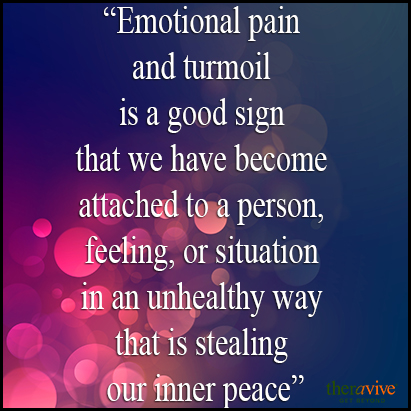 The title of this article is actually a quote from Lama Surya Das in his book, Awakening the Buddha Within (1997). I was so stuck by the simple wisdom of this statement that I posted it on my computer at work, and my refrigerator at home, as a frequent reminder of the dangers of hanging on to things that are better let go. But letting go of feelings, people or situations that are destructive to us, or out of our control, is easier said than done. We hold on and attach for lots of different reasons, but learning to let go and detach in healthy ways can help restore our sense of peace and our relationships with others.
The title of this article is actually a quote from Lama Surya Das in his book, Awakening the Buddha Within (1997). I was so stuck by the simple wisdom of this statement that I posted it on my computer at work, and my refrigerator at home, as a frequent reminder of the dangers of hanging on to things that are better let go. But letting go of feelings, people or situations that are destructive to us, or out of our control, is easier said than done. We hold on and attach for lots of different reasons, but learning to let go and detach in healthy ways can help restore our sense of peace and our relationships with others.
I just can’t let go!
When something or someone has a hold on us, people may say “just let it go, already”. If only it were that easy! Others may notice before we do that we are holding on and stuck. Maybe we are fixated on an argument with a friend or unfair treatment by a supervisor at work. Or, perhaps we are unable to let go of the fact that something didn’t go our way—we didn’t get the outcome we expected. Emotional pain and turmoil is a good sign that we have become attached to a person, feeling, or situation in an unhealthy way that is stealing our inner peace (Shaygan, 2014). Some signs that you are holding on…and getting dragged include:
· Constantly thinking about a person or situation
· Talking a lot or complaining about the person or situation
· Ruminating or obsessing about a person or situation
· Trying to control a person or situation, and create the outcome you want
· Accepting hurtful or abusive behavior from another person
· Struggling with a feeling like anger, resentment, or guilt that will not go away
· Engaging in rigid, all or nothing, thinking
· Being called a “control freak”
· Trying to change the thoughts, feelings, or behaviors of another person
· Experiencing body tension and stress
· Feeling fearful that you will lose control
Buddhist traditions assert that holding on and attachment leads to emotional pain and suffering (Das, 1997). This certainly seems to be true, so why can’t we let go? Holding on gives us the illusion of control, and choosing to let go can be very frightening. If we just try harder, think about it more, or better manage the situation, we will get the outcome we want, right?
The behavior of others and difficult or unfair situations can be tough to accept. If we relax and let go, we may feel we are giving up, giving in, or losing control. But renowned columnist, Ann Landers once said, “Some people believe holding on and hanging in there are signs of great strength. However, there are times when it takes much more strength to know when to let go and then do it.” (Good Reads, 2014). The choice to let go when we need to takes courage and time, but it’s essential for our well-being and the health of our relationships.
The Price of Hanging On
The situations, people, and outcomes that we attach and hold onto have control over us, not the other way around. Our ruminating, managing, and attempts at control steal our inner calm and damage our relationships. Holding on invades the consciousness and actually renders us less able to take constructive action. Some other consequences of holding on include:
· Somatic complaints like stomach aches, headaches and muscle tension
· Sleep disturbance and bad dreams
· Conflict with others and strained or lost relationships
· Frustration, anger, irritability
· Feelings of desperation and fear
· Anxiety, anger, depression, or panic
· Inability to concentrate and focus
· Loss of peace of mind and inner calm
These are signs that it’s time to let go. We pay a steep price for hanging, but letting go is not always a simple thing. As we cling to what we can’t release, we become more and more anxious and exhausted—a sign we are being dragged.
 It’s Time to Let Go
It’s Time to Let Go
First, we must first recognize that we are holding on and having trouble letting go. Notice the effect it has on us and the people around us. Letting go can be very painful and scary, but are steps we can take to detach and let go of the suffering created when we hang on.
· Remember we always have the choice to let go
· Learn to observe and notice the emotional and physical signs (above) of clinging and hanging on
· Remember that we can detach and let go and still care
· Explore fears about letting go or losing control
· Grieve the loss that may come with letting go of a person or a situation
· Become immersed in enjoyable activities and healthy relationships
It’s important to know and accept that letting go is a process that we may need to repeat again and again. Just when we think we have detached, we find ourselves obsessing and controlling again. Letting go of the past, a hurtful relationship, or a destructive situation frees us to move forward on our own path. By choosing to let go and detach from things, we are choosing the peace and contentment we deserve.
_________________________________________________________________________________________________________________________________
Das, S. (1997). Awakening the Buddha within: Eight steps to enlightenment. Sydney: Bantam Books.
Shaygan, L. (2014). Tiny Buddha: Wisdom Quotes, Letting Go, Letting Happiness In. Retrieved May 24, 2014, from http://tinybuddha.com/
Good Reads. (2014). Quotes About Letting Go. Retrieved May 23, 2014, from http://www.goodreads.com/quotes/tag/letting-go